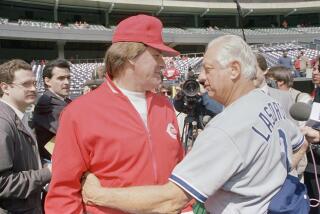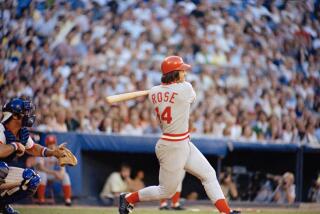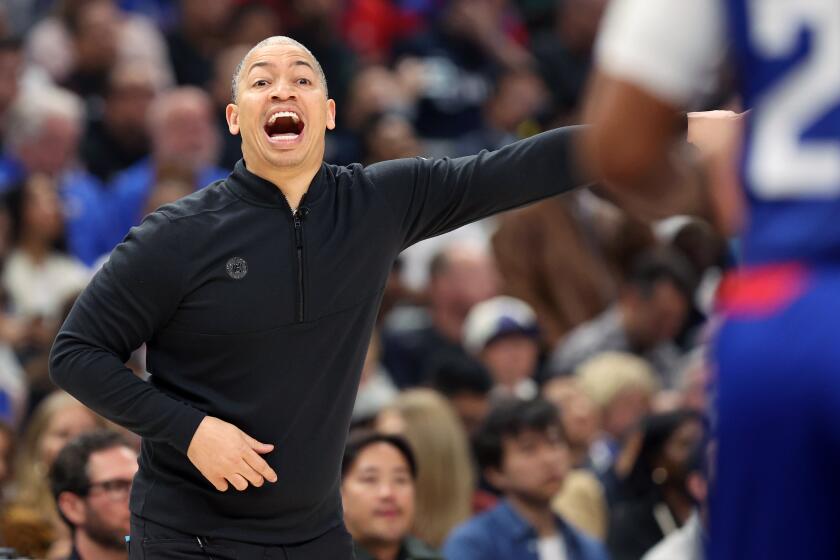Pete Was Intense to the Very End
- Share via
The first striking thing I noticed about Pete Maravich were his layups. The second unusual thing I noticed were his eyes.
I was traveling with the Lakers, just after New Year’s Day in 1979, filling in for this newspaper’s regular Laker writer. The first stop was New Orleans, where the Jazz featured an aging Pistol Pete Maravich.
Maravich came out for pregame warmups wearing knee braces that looked as if they could support a freeway overpass. I watched him shoot layups. He looped each shot, underhand, high into the air in an almost comically exaggerated arc, high off the backboard, as if shooting for the 10-foot-high hoop over an imaginary 14-foot wall.
Obviously, this is a practical technique for any player who takes a lot of shots inside over taller players. But I had never seen anyone else shoot like that in warmups. I still haven’t.
During warmups, unsmiling, he gazed all around the Superdome with, as J.D. Salinger wrote in “For Esme--With Love and Squalor,” “blase eyes that, I thought, might have very possibly counted the house.”
After the game, a tidy win by the Lakers, I went to the Jazz locker room to gather the standard quotes. I had some experience in locker rooms, mostly baseball, and I knew the routine. Ask your question and stare at the player’s back as he eats a chicken leg and mumbles a few cliches.
I spotted Maravich, asked him if he had a minute. He pulled up two stools and invited me to sit. I don’t remember specifically what we talked about, but I remember he looked me dead in the eye when he was talking, and I remember that whatever we talked about, he was very serious, very intense.
As it turned out, I didn’t have to be a genius to make these observations. Pete Maravich was very serious and very intense about everything he did, until Tuesday, the day he died.
In college, he was so serious about his drinking and partying, the basketball games sometimes got in the way. He wound up one night lying in a bar parking lot, beaten to a pulp by a stranger, obviously not a big fan, who had stuck a loaded pistol into Pistol Pete’s mouth.
After his basketball career, Maravich was so serious about UFOs that he painted a target on the roof of his home in fervent hope that a flying saucer would land and take him away.
He was so serious about eating well that he preached to friends. “If you’ve gotta drink coffee, don’t put sugar in it,” he solemnly warned a sportswriter once. “It’s like putting mud in a gas tank.”
He was one of the National Basketball Assn.’s original vegetarians. Since he was eating well, Maravich was so serious about surviving to enjoy his good health that he considered building a bomb shelter.
When Pete found Jesus, visitors to his home were given religious pamphlets.
This was a man not remotely acquainted with frivolity. His mother was an alcoholic who committed suicide. His father was a basketball coach who wanted to be buried with a basketball. When Press Maravich died nine months ago, Pete placed the basketball in his father’s arms in the coffin.
The Maravichs, Press and Pete, took their basketball seriously.
Press’ mission in life was to make Pete the world’s greatest player, and Pete’s mission in life, before he retired from the game, was to push basketball into unexplored solar systems of creativity and entertainment.
Basketball had had some true breakthrough artists, such as Elgin Baylor, Connie Hawkins and Earl (the Pearl) Monroe. Their games came from inner-city playgrounds. But Pistol Pete’s game came from some unknown place, and was geared, more than any other player’s game, to entertaining and amazing the people who bought tickets.
To say that Pete Maravich offended basketball purists with his brazen style would be like saying that Elvis Presley irked a few parents. But to write off Pistol Pete as a colorful hotdog would be like calling Picasso a doodler.
“Sure he offended the purists,” Laker Coach Pat Riley says. “But he also opened the door for the purists to understand that there’s a fine line between pattern ball and spontaneity. If a guy is great, you have to understand that and let him play. We’re in a whole new era now where you’ve got to allow people the opportunity to create and imagine. How else are you going to grow?”
Their pro careers roughly coincided and Riley guarded, or tried to guard, Pistol Pete on numerous occasions.
“I remember one night at the Forum,” Riley says. “I was pressuring him full court. One time he went behind his back, through his legs from back to front, crossed over and went behind his back again. He had me out of my pants.
“Pistol Pete was the original because he did it with a style and personality that defied all the rules of the game.”
Chick Hearn, who really has seen ‘em all, says: “He’s one of a half dozen I’ve ever seen who I’d buy a ticket to see play. He was as dazzling a passer and as great a ballhandler as I’ve ever seen. He was a startling player. He was like a great singer, with a style all his own, a pacing that was different, a flair for the unusual.”
Pistol was, as Hunter S. Thompson wrote recently of a friend, “one of God’s own prototypes, a high-powered mutant of some kind who was never even considered for mass production.”
I had lunch with Maravich a month ago. He was on a tour promoting his book, “Heir to a Dream.” It is the story of his life. The book had a happy ending.
Since finding religion, Pistol Pete had given up his obsession with living forever. Now he just wanted to help everyone live better, more meaningful lives.
He looked me straight in the eye, and he was very serious and very intense.
More to Read
All things Lakers, all the time.
Get all the Lakers news you need in Dan Woike's weekly newsletter.
You may occasionally receive promotional content from the Los Angeles Times.










